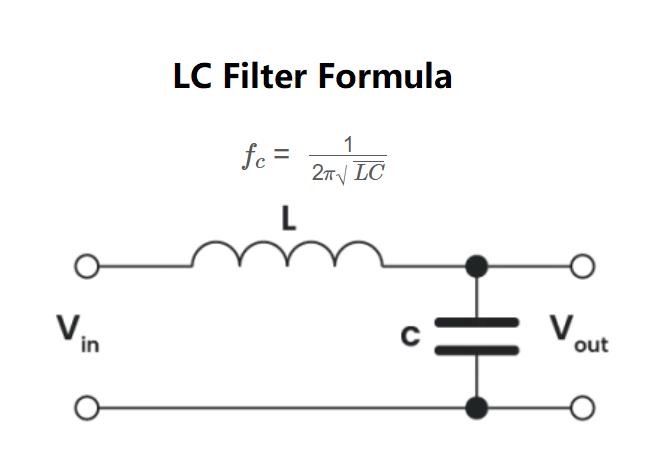1. What is the LC Low-Pass Filter Cutoff Frequency Calculator?
Definition: This calculator computes the cutoff frequency (\( f_c \)) of an LC low-pass filter based on the inductance (\( L \)) and capacitance (\( C \)).
Purpose: It is used in electronics to design LC filters that allow low-frequency signals to pass while attenuating high-frequency signals.

2. How Does the Calculator Work?
The calculator uses the formula:
\( f_c = \frac{1}{2\pi \sqrt{LC}} \)
Where:
- \( f_c \): Cutoff frequency (Hz, kHz, MHz, GHz);
- \( L \): Inductance (H, mH, µH);
- \( C \): Capacitance (F, µF, nF, pF).
Steps:
- Enter the inductance (\( L \)) with its unit.
- Enter the capacitance (\( C \)) with its unit.
- Convert inductance to Henries and capacitance to Farads.
- Calculate the cutoff frequency using \( f_c = \frac{1}{2\pi \sqrt{LC}} \).
- Convert the result to the selected output unit.
- Display the result, formatted in scientific notation if the absolute value is less than 0.001, otherwise with 4 decimal places.
3. Importance of LC Filter Cutoff Frequency Calculation
Calculating the cutoff frequency of an LC low-pass filter is crucial for:
- Electronics Design: Filtering out high-frequency noise in circuits.
- Audio Engineering: Designing crossovers for speakers.
- Signal Processing: Ensuring only desired frequency ranges pass through.
4. Using the Calculator
Example 1: Calculate the cutoff frequency with \( L = 1 \, \text{mH} \), \( C = 1 \, \text{µF} \):
- Inductance: \( L = 1 \, \text{mH} \times 0.001 = 0.001 \, \text{H} \);
- Capacitance: \( C = 1 \, \text{µF} \times 1e-6 = 1e-6 \, \text{F} \);
- Cutoff Frequency: \( f_c = \frac{1}{2\pi \sqrt{0.001 \times 1e-6}} \approx 5032.92 \, \text{Hz} \);
- Result (in Hz): \( f_c = 5032.9200 \, \text{Hz} \).
Example 2: Calculate the cutoff frequency with \( L = 100 \, \text{µH} \), \( C = 10 \, \text{nF} \):
- Inductance: \( L = 100 \, \text{µH} \times 1e-6 = 1e-4 \, \text{H} \);
- Capacitance: \( C = 10 \, \text{nF} \times 1e-9 = 1e-8 \, \text{F} \);
- Cutoff Frequency: \( f_c = \frac{1}{2\pi \sqrt{1e-4 \times 1e-8}} \approx 50329.21 \, \text{Hz} \);
- Result (in kHz): \( f_c = 50.3292 \, \text{kHz} \).
5. Frequently Asked Questions (FAQ)
Q: What is a low-pass filter?
A: A low-pass filter allows signals with a frequency lower than the cutoff frequency (\( f_c \)) to pass through while attenuating higher frequencies.
Q: Why use an LC filter?
A: LC filters are simple and effective for filtering applications, offering sharp cutoff characteristics with minimal components.
Q: Does this calculator account for resistance?
A: No, this calculator assumes an ideal LC circuit with no resistance. Real-world filters may have damping effects due to resistance.
LC Low-Pass Filter Cutoff Frequency Calculator© - All Rights Reserved 2025
 Home
Home
 Back
Back

